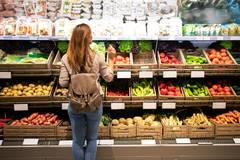UK food inflation to spike as regulatory and climate change pressures mount, warns FDF
The UK’s F&B sector could face a challenging inflation trend over the next two years, warns the Food and Drink Federation (FDF). Food prices are predicted to rise by 5.7% by December 2025, before slowing to 3.1% by the end of 2026.
Regulatory pressures are the leading factors driving inflation, while traditional cost drivers like energy and agricultural inputs have “stabilized,” states the organization in its Food Inflation Forecast 2025-26 report.
Food and non-alcoholic beverage prices increased by 37% between January 2020 and July 2025, compared with 28% for general UK inflation. Milk, cheese, eggs, and oils accounted for the steepest increases.
Based on the Office for National Statistics (ONS) figures, the annual inflation rate for food and non-alcoholic beverages increased to 5.1% in August, up from 4.9% in July. This was the fifth consecutive monthly rise and the highest recorded rate since January 2024.
Karen Betts, chief executive of the FDF, says: “It’s concerning seeing food and drink inflation rise further, to 5.1% in August, when commodity and energy prices are fairly stable. There are still notable pressures on coffee, cocoa, olive oil, and dairy prices, but otherwise the continued rise is explained by regulatory and tax costs.”

Regulatory changes weigh in
Betts further stresses the impact of regulations driving F&B inflation.
“This year’s increases to employer National Insurance Contributions, the new packaging tax, business rates rises, and the cost of border checks, including those to Northern Ireland, are heaping costs on our sector.”
 While geopolitical challenges drove inflation between 2020 and 2023, domestic policies are leading to the new inflation surge, says FDF lead economist Dr. Liliana Danila.The report highlights that packaging rules, such as the Extended Producer Responsibility (EPR) scheme, will add an estimated £1.1 billion (US$1.3 billion) in costs for food and drink businesses from October 2025. “The Deposit Return Scheme, due in 2027, will add more,” it states.
While geopolitical challenges drove inflation between 2020 and 2023, domestic policies are leading to the new inflation surge, says FDF lead economist Dr. Liliana Danila.The report highlights that packaging rules, such as the Extended Producer Responsibility (EPR) scheme, will add an estimated £1.1 billion (US$1.3 billion) in costs for food and drink businesses from October 2025. “The Deposit Return Scheme, due in 2027, will add more,” it states.
Dr. Liliana Danila, the lead economist at the FDF, says: “Inflationary spikes between 2020 and 2023 were driven by geopolitical shocks, which created supply chain disruptions and sharp rises in energy and raw ingredients.”
“With most of these costs now stabilized, this new inflation surge is fueled by the financial impact of domestic policies, now trickling down to supermarket shelves.”
The FDF also considers Brexit, the COVID-19 pandemic, and the war in Ukraine to have had a deeper impact on the food and drink manufacturing industry than the rest of the economy.
The UK imports nearly 42% of the food it consumes, and new post-Brexit checks have added costs. “Import certificates (since January 2024) and full border checks (since April 2024) have raised import prices substantially,” states the report.
“Double-digit” inflation
The ONS reported a “mixed performance” in 49 food and non-alcoholic drink product categories. Five of them saw inflation in double digits — beef and veal (24.9%), butter (18.9%), chocolate (15.4%), coffee (15.4%), and whole milk (12.6%).
The fastest price deflation was seen in olive oil (-12.5%), flours (-5.9%), sugar (-3.8%), and pasta (-2.8%). Olive oil is falling year-on-year, but is still over 120% higher than it was at the start of 2020.
FDF’s report highlights that the UK has also outpaced most comparable European countries regarding food prices since 2023. By July, UK food inflation stood at 4.9% — much above that of France (1.8%), Germany (2.7%), or Spain (2.8%).
 Beef and veal witnessed a double digit inflation (24.9%), along with butter (18.9%), chocolate (15.4%), coffee (15.4%), and whole milk (12.6%).“[UK food price inflation] is an outlier against comparable European economies, and it’s persisting in the absence of energy or commodity shocks. The costs are such that companies can no longer absorb them and are having to pass at least some of them onto consumers,” reads the report.
Beef and veal witnessed a double digit inflation (24.9%), along with butter (18.9%), chocolate (15.4%), coffee (15.4%), and whole milk (12.6%).“[UK food price inflation] is an outlier against comparable European economies, and it’s persisting in the absence of energy or commodity shocks. The costs are such that companies can no longer absorb them and are having to pass at least some of them onto consumers,” reads the report.
Pressure on households
Between January 2020 and July 2025, food and drinks saw particular price surges in olive oil (118%), eggs (57%), butter (53%), and yogurt (50%).
“When prices rise, families are forced to allocate a larger share of their income to food, leaving less for other essentials such as housing, healthcare, education, and savings,” underscores the report.
The poorest households spend a significantly higher proportion of their income on food (12.8%) compared to the richest (8.7%).
In recent years, food manufacturers have “absorbed rising costs” to help ease the financial burden on consumers. However, due to consistent periods of production cost pressures, price rises have eventually reached supermarket shelves.
“Households spend £70.50 (US$83.27) a week on food and drink, nearly double the £38.50 (US$45.47) spent on energy,” reads the report.
Climate shocks and cost of living crisis
In addition to regulatory pressures, factors like climate change and changing consumer purchasing habits are also contributing to inflated food costs.
“UK households, squeezed hard by the cost-of-living crisis, are buying 5.8% less food (in volume terms) than in 2019, despite population growth. Export volumes are also down 31.3% compared to 2019,” underscores the report.
This has created mounting pressure on food manufacturers, especially those operating in a low-margin environment.
Meanwhile, climate stressors are increasingly “destroying crops and disrupting harvest cycles,” FDF highlights.
 The FDF urges the government to reduce cost pressures such as by using the £1.1 billion EPR fees to boost recycling and avoid higher bills.“In the UK, farmers are preparing for a second consecutive year of poor harvests. Wheat production alone is projected to be around 9% below the ten-year average.”
The FDF urges the government to reduce cost pressures such as by using the £1.1 billion EPR fees to boost recycling and avoid higher bills.“In the UK, farmers are preparing for a second consecutive year of poor harvests. Wheat production alone is projected to be around 9% below the ten-year average.”
What can be done?
The FDF calls on the government to reduce existing cost pressures. For instance, the £1.1 billion (US$1.3 billion) fees for the EPR scheme must be used to boost recycling rates to avoid producers facing higher bills in the coming years.
This could also include not increasing the current rates that the industry pays on taxes, such as the Soft Drinks Industry Levy.
Betts stresses that the government needs to bring down the cost of regulation. “As this Autumn’s Budget looms, it’s critical that the government does not add further to the already high costs of regulation in our sector.”
“We’re calling on the government to help us turn this tide by partnering with industry to attract investment, accelerate productivity growth, boost skills, and grow exports across our sector. This will help counter inflation and secure a more resilient future for UK food and drink manufacturing.”
















